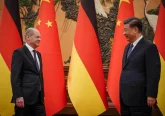The new buzzword echoing through the halls of the White House is variable geometry. Faced with a panoply of transnational threats, the Biden administration is building fit-for-purpose coalitions between countries and other stakeholders, including local governments, the private sector, NGOs, and academia. Coalitions have been formed to address discrete policy challenges, including COVID-19, food security, providing aid to displaced Ukrainians, and most recently, synthetic opioids. In times of polycrisis, variable geometry suggests that the “America First” policy is no longer viable. Yet, the diplomatic currency of the United States remains zero-sum; official statements about defending the liberal world order continue to echo the end of history thesis, without accounting for the growing demands of middle powers – particularly those in the Global South.
Dubbed by Jake Sullivan as the “steering committee of the free world”, the Group of Seven (G7) is the engine behind Washington’s coalition-building strategy. Although the G7 has coordinated solutions on trade, security, the economy, and climate change since its founding in 1975, the Russo-Ukrainian War has breathed new life into the transatlantic alliance. In the context of the war, the G7 serves a dual-purpose function, uniting states both against common enemies (China and Russia) and for a common cause (the protection of liberal democracy). While the G7 has cemented ties between the US and long-established partners like the European Union (EU) and NATO, it is also reinforcing cooperation with less traditional allies, especially the Association of Southeast Asian Nations (ASEAN).
Economic statecraft has been key to solidifying partnerships and determining the perimeters of Biden’s geopolitical geometry. Although sanctions have been used as a tool of modern warfare since the interwar period, policymakers have traditionally approached economic and military security as two separate domains. Russia’s invasion of Ukraine has blurred this distinction, resulting in the creation of a weaponised economy on an unprecedented scale. Within days of the invasion, the G7 and EU imposed unilateral sanctions and export controls to freeze Russia’s foreign currency reserves and minimise their economic dependence on Moscow. In response, Russia and China have promoted alternative financial structures in an attempt to dethrone ‘King Dollar’. Crucially, it’s not just the dragon and the bear that are leading de-dollarisation initiatives. From India to Brazil, Argentina to South Africa, and the Middle East to Southeast Asia, ways are being explored to reduce reliance on, if not replace, the dominant currency in global trade.
According to former UN Secretary-General Kofi Annan, sanctions are a “necessary middle ground between war and words”. But in the West’s attempt to maintain the liberal status quo, unilateral sanctions are a double-edged sword. As one Chinese official asserted: “Sanctions are not such a bad thing. They only strengthen the de-westernisation movement”. Since the start of the war, Chinese exports to Russia — especially motor vehicles, electronics, chips and integrated circuits, and machinery — have reached record-levels. Analysts have argued that while Moscow’s “yuanisation” may mitigate the impact of Western sanctions, it creates new risks and vulnerabilities vis-à-vis Beijing. However, it seems that the Kremlin’s isolation has paved the way for greater cooperation on both sides. Although China initially adopted a neutral stance for fear of secondary US sanctions, any illusions about Beijing’s alignment were shattered by the Putin-Xi joint statement issues in March 2023. In the same month, China invested $11 billion into the port of Vladivostok, marking a symbolic shift in the countries’ trade relations.
Meanwhile, as Europe has weaned itself off Russian gas, India’s investment in Russia’s energy sector has soared. After the West imposed a price cap on Russian oil ($60 per barrel), Moscow made New Delhi an offer it could not refuse. Between February 2022 and 2023, India’s oil imports from Russia rose from 1 percent (3.6 million tonnes) to 40 percent (56 million tonnes) of the country’s gross oil imports. Despite this increase in bilateral trade and Russia remaining India’s top arms supplier, Indo-Russian diplomatic ties have cooled in the face of continued Sino-Russian cooperation and increased US and EU interest in India.
When it comes to Washington’s coalition-building, political appetite has often failed to match practical reality. At the most recent US-ASEAN Summit, President Biden was expected to pledge unwavering support for ASEAN centrality and the four pillars of the “strategic partnership”: maritime cooperation, connectivity, the UN Sustainable Development Goals, and economic cooperation. But Biden was a no-show at both the ASEAN and East Asia summits – a move interpreted by several Southeast Asian countries as a diplomatic snub. In the game of great power competition, miscalculations of this magnitude risk derailing the US campaign to counter China’s foothold in the region.
Antony Blinken’s efforts to depart from the black-and-white mentality of the Cold War are being undermined by his zero-sum narratives pitting the West against a “rising China” and “revanchist Russia”. The Manichean framing of a New Cold War precludes any possibility of forging meaningful alliances beyond those established in the 20th century. Where, for example, does the newly expanded BRICS bloc fit into Blinken’s “contest to shape the future”? While Russia and Iran have banded together in their diplomatic isolation, the entry of Saudi Arabia and the United Arab Emirates (UAE) into BRICS+ symbolises a withdrawal from Washington’s orbit, as the oil producers strive to become major powers in their own right. Importantly, moving away from the U.S. does not necessarily mean moving closer to China or Russia. Rather, it reflects the tendency of middle powers to strategically hedge between superpowers and take economic advantage of great power rivalry.
In Africa, Kamala Harris’ recent charm offensive was too little, too late. As bilateral trade between China and Africa continues to soar, the US should refrain from treating Beijing like a nemesis on the continent. To enlist the support of African nations at the United Nations — where they represent more than a quarter of the General Assembly’s members — Biden must expand on, rather than try to compete with, Chinese investment and infrastructure projects. This is particularly crucial in the domain of renewable energy, where Beijing has invested billions of dollars in creating off-grid systems. With abundant wind, solar, and hydropower resources, Africa has untapped potential for renewable energy development. Instead of trying to undermine China’s influence on the continent, the US should offer viable alternatives to the Green Silk Road Initiative.
If variable geometry is to be more than a rallying cry for sustainable development and strategic realignment, Washington must shed its “with or against us” mentality. The war in Ukraine is not only a watershed moment for economic statecraft, but also an unprecedented opportunity to forge new and more equal alliances between the West and the Global South. To do so, the Biden administration must transcend the liberal-illiberal dualism that has characterised its foreign policy strategy to date. Innovative policymaking centred on compromise rather than competition could make all the difference in shaping the post-post-Cold War era.






